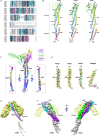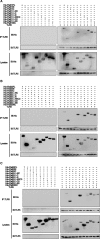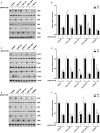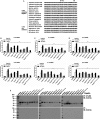The N-terminal D1 domain of Treponema pallidum flagellin binding to TLR5 is required but not sufficient in activation of TLR5
- PMID: 31493340
- PMCID: PMC6815820
- DOI: 10.1111/jcmm.14617
The N-terminal D1 domain of Treponema pallidum flagellin binding to TLR5 is required but not sufficient in activation of TLR5
Abstract
Syphilis is a chronic bacterial infection caused by Treponema pallidum (T pallidum) and the pathogenesis that T pallidum infection induces immunopathological damages in skin and other tissues remains unclear. We have previously reported that recombinant flagellins of T pallidum can elicit IL-6 and IL-8 transcriptions via TLR5 pathway. To identify the domains which induced the pro-inflammatory activity and the importance of the interactions between TLR5 and domains, homology-based modelling and comparative structural analyses revealed that Tpflagellins can combine with TLR5 directly. Deletion mutations showed that the ND1 domain binding to TLR5 is required but not sufficient in TLR5 activation. Moreover, site-directed mutagenesis analysis indicated that the arginine residue (Tpflagellins R89) of the ND1 domain and its adjacent residues (Tpflagellins L93 and E113) constitute a hot spot that elicits IL-6, IL-8 transcriptions and TLR5 activation, and affects the binding of Tpflagellins to TLR5. Taken together, these results give insight into the pathogenesis of T pallidum and may contribute to the future design of Tpflagellins-based therapeutics and syphilis vaccine.
Keywords: Treponema pallidum; N-terminal D1 domain; TLR5 signalling; flagellin; inflammation.
© 2019 The Authors. Journal of Cellular and Molecular Medicine published by John Wiley & Sons Ltd and Foundation for Cellular and Molecular Medicine.
Conflict of interest statement
The authors declare no conflict of interest.
Figures







Similar articles
-
Treponema pallidum flagellins elicit proinflammatory cytokines from human monocytes via TLR5 signaling pathway.Immunobiology. 2017 May;222(5):709-718. doi: 10.1016/j.imbio.2017.01.002. Epub 2017 Jan 21. Immunobiology. 2017. PMID: 28126263
-
Treponema pallidum flagellins stimulate MMP-9 and MMP-13 expression via TLR5 and MAPK/NF-κB signaling pathways in human epidermal keratinocytes.Exp Cell Res. 2017 Dec 1;361(1):46-55. doi: 10.1016/j.yexcr.2017.09.040. Epub 2017 Oct 2. Exp Cell Res. 2017. PMID: 28982539
-
A conserved TLR5 binding and activation hot spot on flagellin.Sci Rep. 2017 Jan 20;7:40878. doi: 10.1038/srep40878. Sci Rep. 2017. PMID: 28106112 Free PMC article.
-
Structural engineering of flagellin as vaccine adjuvant: quest for the minimal domain of flagellin for TLR5 activation.Mol Biol Rep. 2025 Jan 7;52(1):104. doi: 10.1007/s11033-024-10146-y. Mol Biol Rep. 2025. PMID: 39775323 Free PMC article. Review.
-
AsialoGM1 and TLR5 cooperate in flagellin-induced nucleotide signaling to activate Erk1/2.Am J Respir Cell Mol Biol. 2006 Jun;34(6):653-60. doi: 10.1165/rcmb.2005-0441OC. Epub 2006 Jan 26. Am J Respir Cell Mol Biol. 2006. PMID: 16439799 Free PMC article. Review.
Cited by
-
Characterizing the immune infiltrate in secondary syphilis: implications for transmission and pathology.Front Immunol. 2025 Mar 25;16:1549206. doi: 10.3389/fimmu.2025.1549206. eCollection 2025. Front Immunol. 2025. PMID: 40201184 Free PMC article.
-
Escape of TLR5 Recognition by Leptospira spp.: A Rationale for Atypical Endoflagella.Front Immunol. 2020 Aug 11;11:2007. doi: 10.3389/fimmu.2020.02007. eCollection 2020. Front Immunol. 2020. PMID: 32849665 Free PMC article.
-
Bacterial Flagellar Filament: A Supramolecular Multifunctional Nanostructure.Int J Mol Sci. 2021 Jul 14;22(14):7521. doi: 10.3390/ijms22147521. Int J Mol Sci. 2021. PMID: 34299141 Free PMC article. Review.
-
Research progress on Toll-like receptor signal transduction and its roles in antimicrobial immune responses.Appl Microbiol Biotechnol. 2021 Jul;105(13):5341-5355. doi: 10.1007/s00253-021-11406-8. Epub 2021 Jun 28. Appl Microbiol Biotechnol. 2021. PMID: 34180006 Free PMC article. Review.
-
The Role of Flagellin B in Vibrio anguillarum-Induced Intestinal Immunity and Functional Domain Identification.Front Immunol. 2021 Nov 29;12:774233. doi: 10.3389/fimmu.2021.774233. eCollection 2021. Front Immunol. 2021. PMID: 34912344 Free PMC article.
References
Publication types
MeSH terms
Substances
LinkOut - more resources
Full Text Sources
Other Literature Sources

